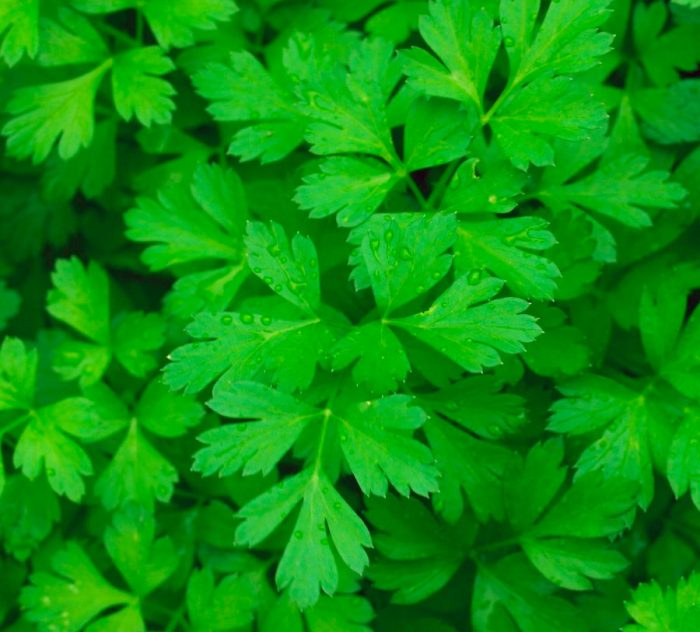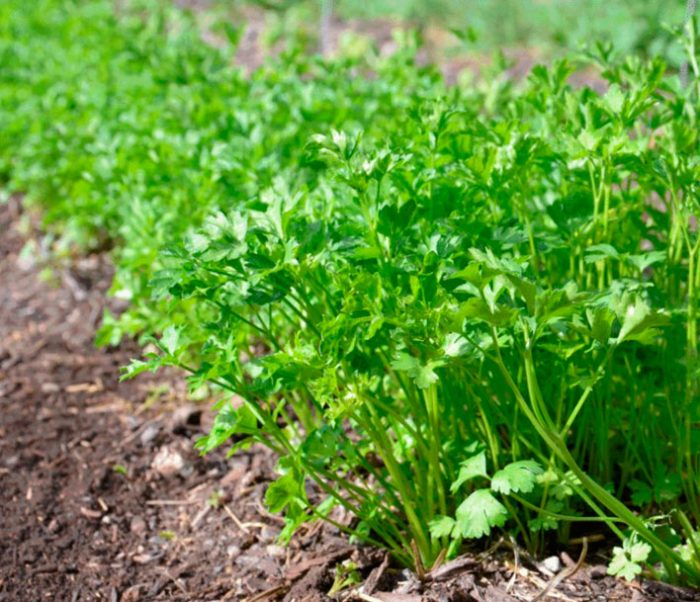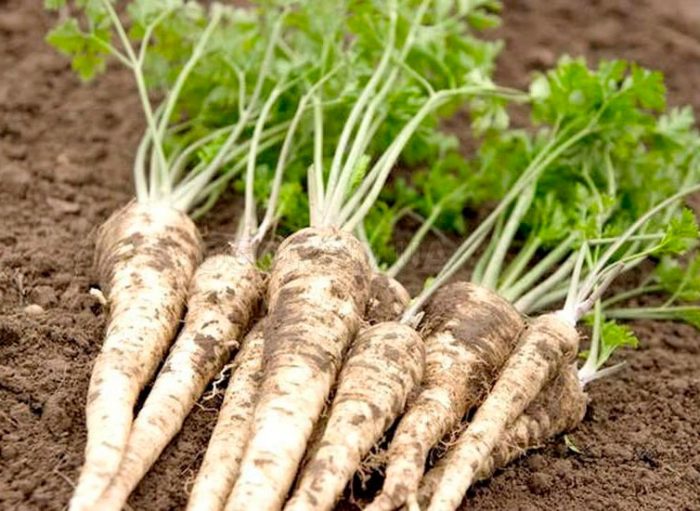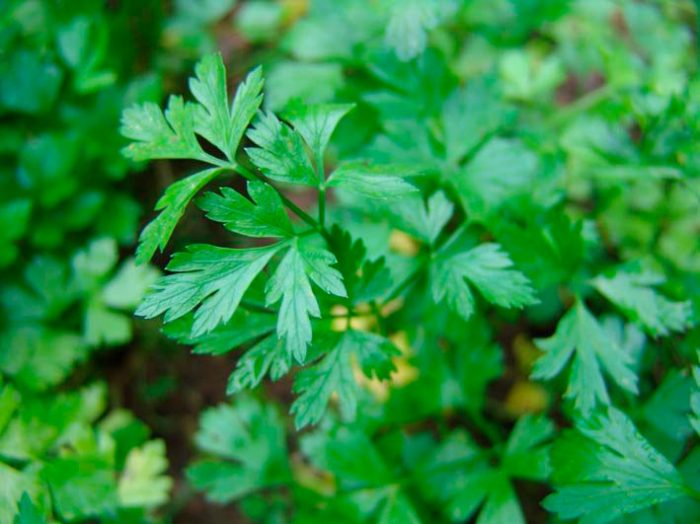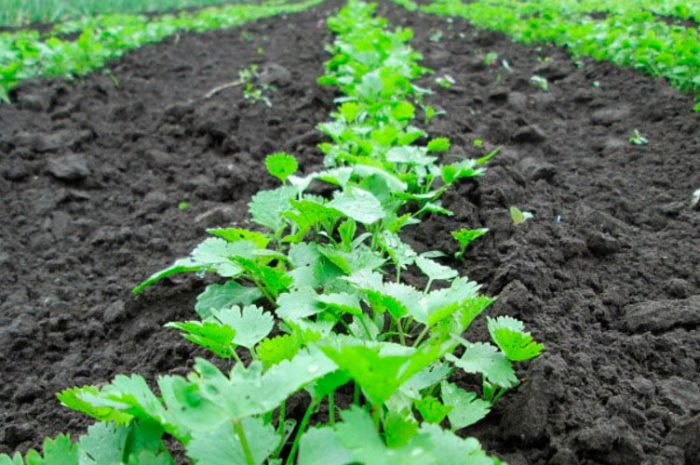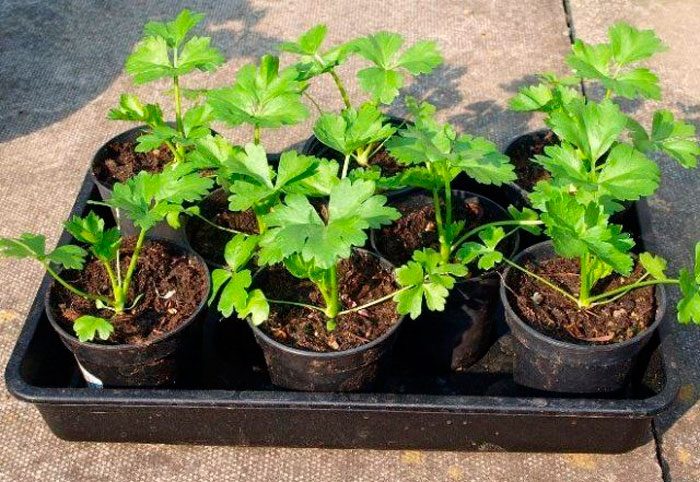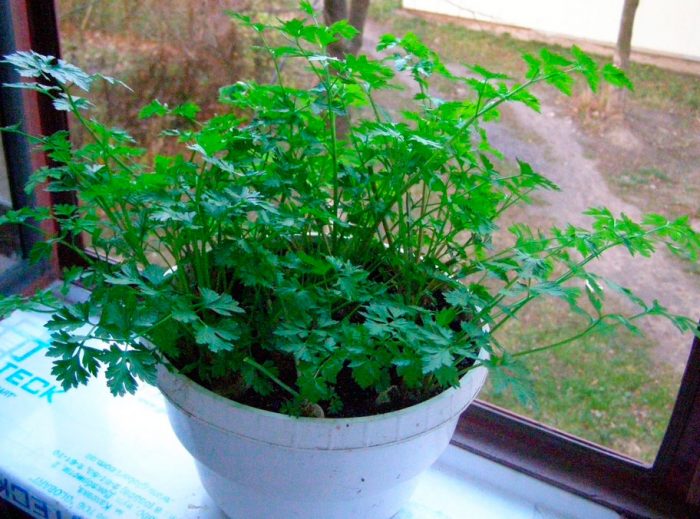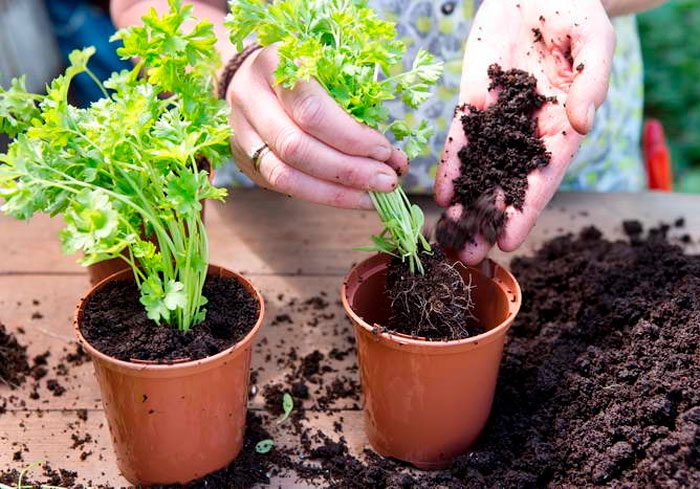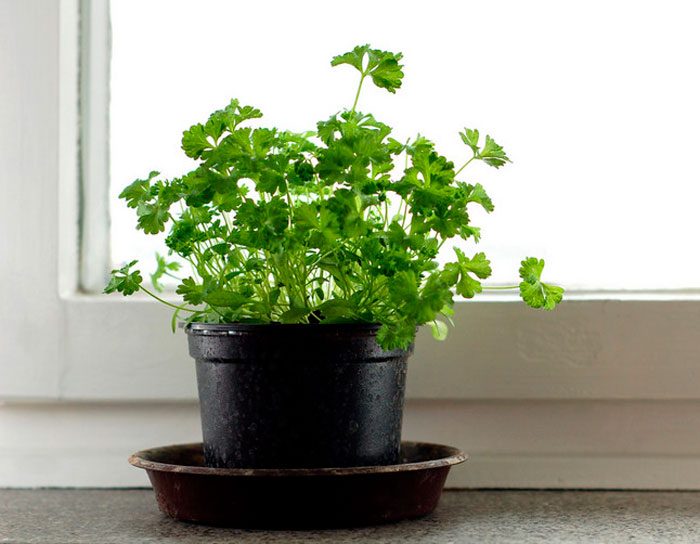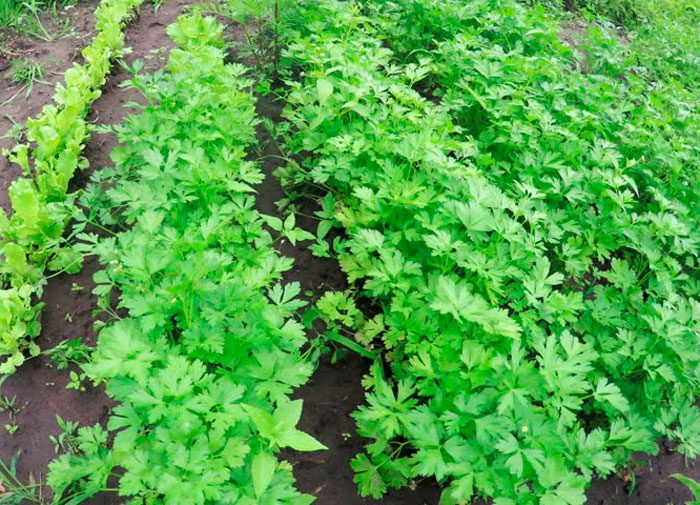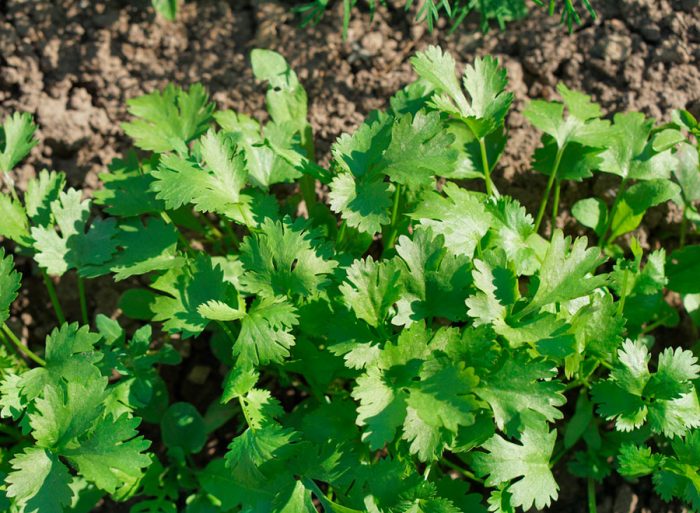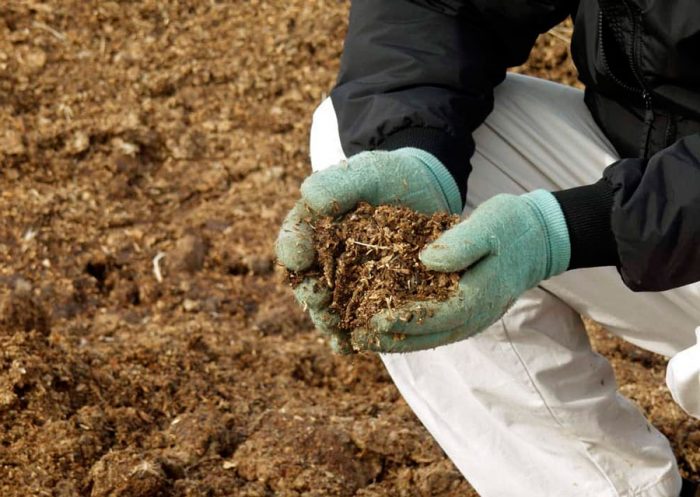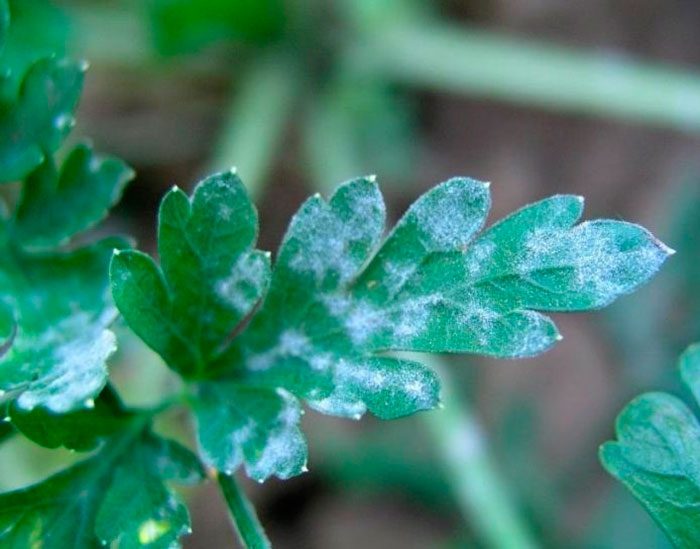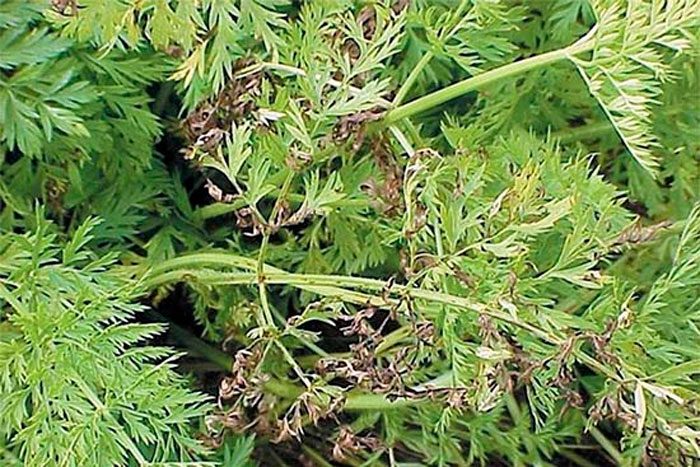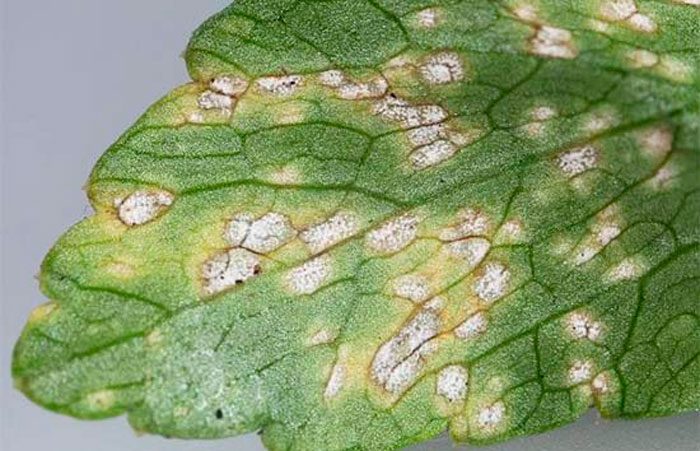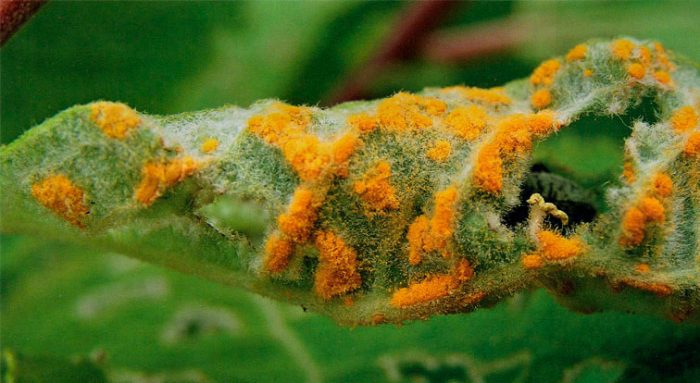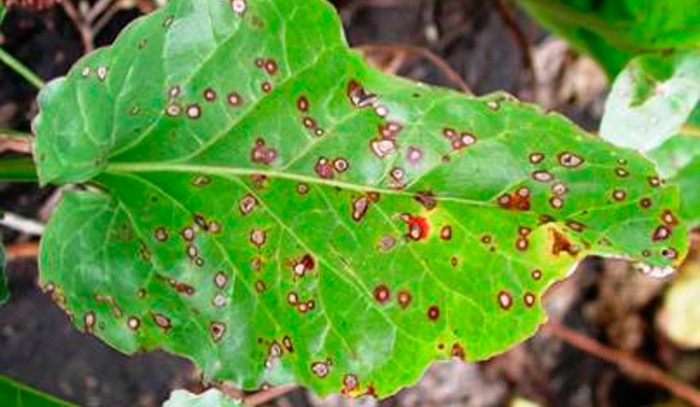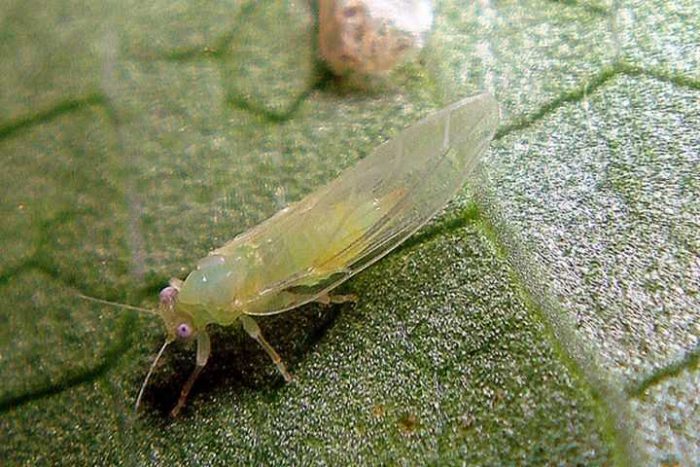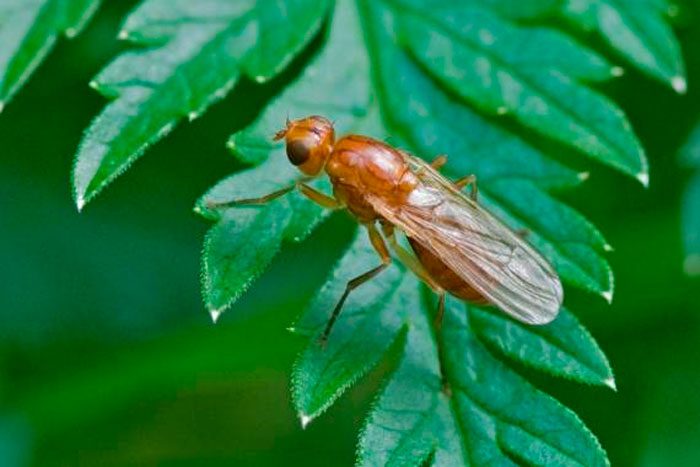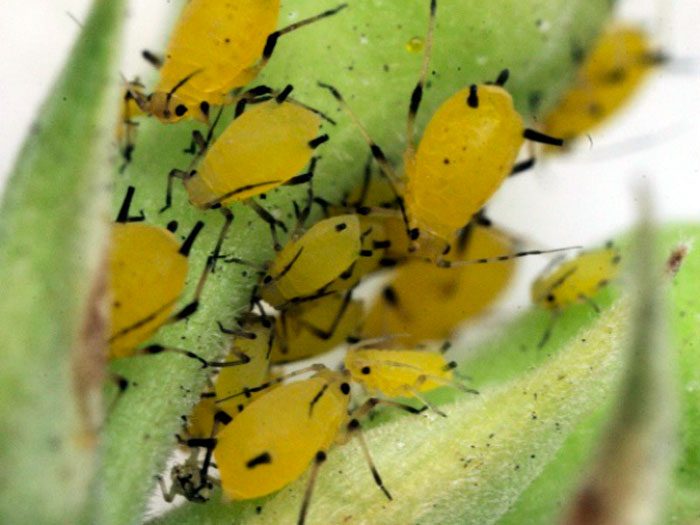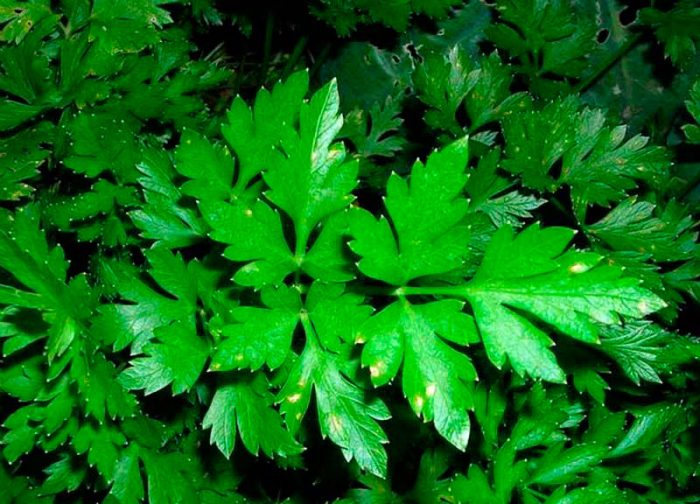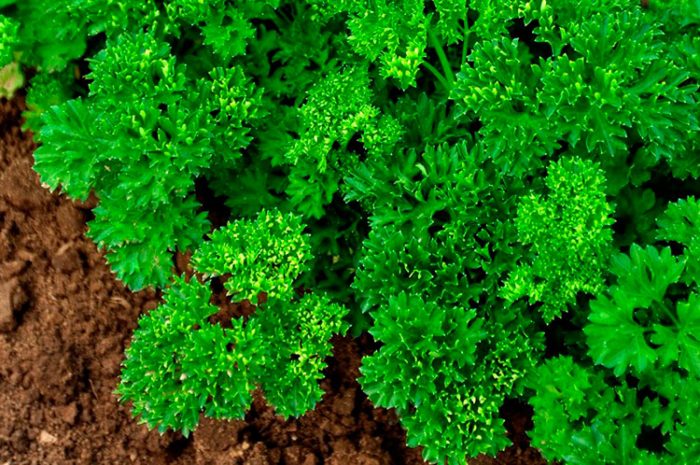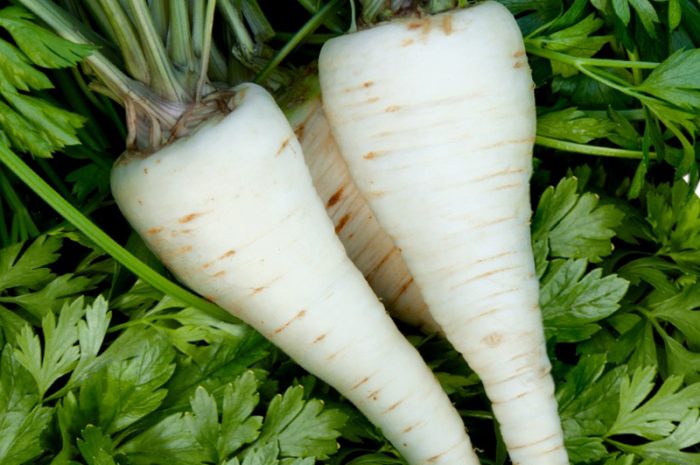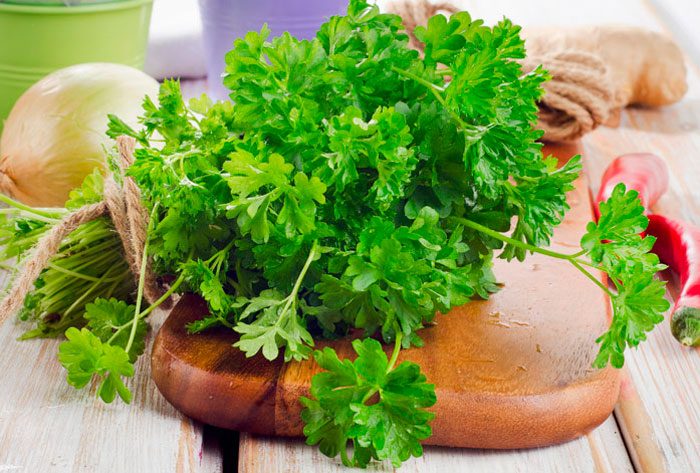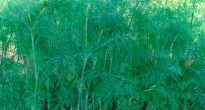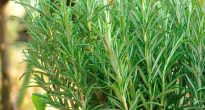The herbaceous biennial plant parsley (Petroselinum) is a small genus that belongs to the Celery family (Umbelliferae). This plant comes from the island of Sardinia. The first mention of him was found in ancient Egyptian papyri: according to legend, this culture grew out of the blood that flowed out of the eye of Horus, the son of the god Osiris, he was pulled out by the evil Set. Under natural conditions, such a herbaceous plant is found on the coast of the Mediterranean Sea. Root and leaf parsley is cultivated in the southern part of Canada and in the north of the States, as well as throughout continental Europe except Scandinavia. The most popular among gardeners is root parsley, as it forms a root vegetable and also produces greens.
Content
Features of parsley
Parsley is a herbaceous plant that can be an annual or a biennial. Its stem is erect, and the leaf plates are double- or triple-pinned. The petals of heart-shaped flowers are yellow-green or whitish, sometimes they have a pale red tint at the base. The fruit is ovoid and laterally compressed.
This culture is moisture-loving and frost-resistant. Seed germination is observed at a temperature of 1–5 degrees, while the seedlings can withstand frosts down to minus 9 degrees. In this regard, in regions with mild, non-frosty winters in autumn, it is not necessary to extract the root of such a plant from the soil.
Root parsley
During the first year of growth, the bushes form a leaf rosette and a root vegetable that looks like a carrot, it is painted in a pale yellow or white color. And in the second year, the bushes give seeds. Parsley roots have medicinal properties, they help to preserve vision, heal wounds, strengthen the gums, and also stimulate kidney activity. They contain salts of potassium, iron and phosphorus. This root vegetable is used as a spice, adding it to soups and pickles, as well as to marinades when canning.
Leaf parsley
Leaf parsley does not form a root crop, but it has a well-developed and branched root system. The greens of such a plant are added to salads, and also used as a spice for fish and first courses. Such greens are eaten not only fresh, but they are also dried and frozen, if such parsley is stored correctly, then it can retain its useful substances for up to 12 months. This culture is still widely used in cosmetology, as well as in traditional and folk medicine.
Planting parsley outdoors
What time to plant
Parsley can be grown through seedlings or sown directly into the ground, while the second method is more popular with gardeners. With the help of seedlings, such a plant is grown only in certain regions. Sowing seeds in open soil is carried out from mid to late April, and it can also be done in autumn, namely, starting from mid October. In order for parsley to be on the table throughout the summer, it is recommended to sow it using a conveyor method: once every 15 days until the last days of July.
A suitable area for sowing should be sunny, while the soil needs to be loose, not very moist, light and rich in nutrients. Best of all, such a culture grows on light sandy loam or loam with a pH of 6.5-7.0. For sowing parsley, experts do not advise choosing a site with a high groundwater table. If there is no other place for growing, then you need to make high beds. You can grow parsley on the site after the following crops: onions, tomatoes, zucchini, squash, potatoes, cabbage and cucumbers. Bad predecessors are representatives of the Umbrella family, for example: carrots, parsley, celery, fennel, coriander, dill, etc. However, parsley can be grown with them, for example, in the same area you can grow carrots and parsley, dill and parsley, cilantro and parsley, etc. You can also grow it in the same area with cucumbers, legumes and tomatoes.
Landing rules
If the sowing of such a plant is planned for the spring, then the preparation of the site must be done in the autumn. If the sowing of seeds is carried out before winter in the autumn, then the site will need to be prepared no less than 15–20 days before the day of sowing. For root (feed) parsley, manure must be added to the soil, but this is done about 12 months before sowing such a crop before growing the predecessor plant. Leafy (green) parsley grows well on manure. During the digging of the site in the autumn, 4 to 5 kilograms of manure (compost) should be added to the soil per 1 square meter. If the soil is poor, then, in addition to organic fertilizers, a complex of minerals is also added to it, but this must be done in spring when preparing the site for sowing. If a winter sowing of such a plant is planned, then organic matter and minerals must be added to the soil at the same time. Since dry seeds germinate very slowly, they are recommended for 30 minutes. immerse in water, after which the seed is dried until it begins to crumble.
In the prepared area, grooves should be made, reaching a depth of 10-15 mm, while the width between them should be about 0.5 m. The grooves should be spilled abundantly with lukewarm water, and after it is completely absorbed, the seeds are sown. The grooves must be covered with soil, after which it is tamped. As a rule, the first seedlings appear after 15–20 days. In autumn, dry seeds are used for sowing, then the surface of the garden is covered with a layer of mulch (humus or peat).


Watch this video on YouTube
Growing parsley seedlings
How to sow parsley seeds in open ground is described in more detail above.But in some cases, such a plant is grown in seedlings. Before starting sowing, the seeds must be soaked in water, where they must stay for 24 hours, this will allow them to be cleaned of essential oils that slow down germination. Then the seed must be placed in a damp cloth. After white sprouts appear, the seeds are sown, after having dried them until they flow. A picking of seedlings should be carried out after two true leaf plates begin to form in them, for this they use peat pots. After 8 weeks have passed from the moment of sowing the seeds, the root parsley seedlings must be planted in open soil. It is planted together with the pots, and, depending on the variety, a distance of 7-15 centimeters is maintained between the bushes. When planting seedlings of leaf parsley, a distance of at least 20 centimeters should be kept between them. The distance between the rows should be about 0.5 m. In this case, the preparation of the site must be done in advance.
Growing parsley on a windowsill
In order to grow parsley at room conditions, it should be sown in the same way as described above, for this, seedling boxes filled with soil mixture from vermicompost and coconut fiber are used, which is laid out on top of the drainage layer. Seed material needs pre-sowing preparation. To do this, it is placed in a container with water for two or three days, which must be replaced twice a day. In this case, 2 hours before sowing, the seeds should be disinfected by immersing them in a weak solution of potassium permanganate. The seeds must be buried in the soil mixture no more than 5 mm, then the surface of the substrate is covered with loose soil, while the layer thickness should be about 10 mm. Then the box is removed to a dark place. In order for the seedlings to appear as quickly as possible, the containers on top should be covered with a film or glass, but at the same time it is necessary to regularly ventilate the crops, and also remove condensate from the surface of the shelter in a timely manner.
After the first seedlings appear after 15–20 days, the container with the crops must be transferred to the windowsill. When the seedlings grow up, they need to be thinned out, while the distance between the plants should be at least 40 mm. The optimum air temperature for growing parsley is from 15 to 20 degrees. If the room is colder, the growth of the plants will become slower, and in the heat the seedlings dry out. For seedlings to grow normally, they need a long day of light. If it is shorter than necessary, then the parsley will need additional artificial lighting; for this, a fluorescent lamp must be placed at a distance of 0.6 m. After about 6 weeks the first crop can be harvested. When the height of the branch reaches 10-12 centimeters, if necessary, you can pick it off and use it for cooking, while part of the stem with 1/3 of the leaf plates should remain in the container.
For growing indoors, it is recommended to use early varieties, in this case, the first harvest is carried out half a month earlier than when growing late and mid-season varieties. Most often, such green varieties are grown on the windowsill as: Astra, Russian feast, Fitness, Beads, Green pearls, Morning freshness, Gloria, etc.
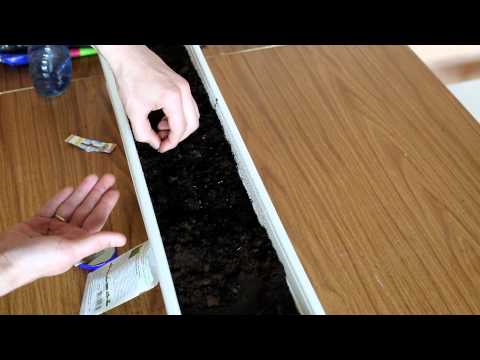

Watch this video on YouTube
How to grow from a root vegetable
This method of growing parsley allows you not to wait for the seedlings to appear. In the last days of October, before the frost begins, the parsley bush must be removed from the ground with roots about 50 mm long and about 40 mm wide. To disinfect the seedling box, you need to use a strong solution of potassium manganese; at its bottom, you need to make a drainage layer, on top of which a soil mixture for violets is poured.The roots of this plant, which were dug out in the garden, should be planted in it almost close to each other, while only the apical buds should rise above the surface of the substrate. The soil mixture must be slightly compacted and watered well, after which the container is transferred to an unheated veranda or to an insulated balcony. Plants need to be provided with moderate watering, and after the appearance of green sprouts, the container is transferred to a well-lit and warm (about 20 degrees) room. Young plants will need additional lighting on a cloudy day. After the active growth of green mass begins, watering should be made more frequent and abundant. If everything is done correctly, fresh fragrant greens will grow by the New Year holidays.
How to water
Growing parsley indoors, it needs to provide systematic moderate watering. The substrate in containers should not dry out, and water stagnation in the soil mixture should not be allowed. Water such a plant every day with a moderate amount of water at room temperature. After a crust appears on the surface of the substrate, it is removed, for this it is necessary to loosen the soil mixture.
Fertilizer
If this culture is grown from seeds, then the seedlings will need liquid fertilizing, for this they use an environmentally friendly fertilizer, it should be applied no more than 2 times every 4 weeks. To do this, you can use organic matter or mineral complex fertilizers, which have proven themselves well.
Pertushka care
Growing such a crop in open soil is easy enough. To do this, the bushes must be thinned out, weeded, fed, watered, and also loosened up the surface of the beds in time. In spring, while parsley is still very weak, it needs special protection from weeds, because they can drown out any cultivated plant. In this regard, the parsley will need to be systematically weeded, while the weeds should be removed both from the rows and from the aisles. It is recommended to carry out this procedure 24 hours after the rain has passed or the bed will be watered, while, along with the removal of weeds, the soil surface must also be loosened. Loosening improves aeration of the root system of the bushes.
How to water
When grown in a garden, this crop will need to be systematically watered. It should be noted that root varieties are less demanding for watering than leaf varieties. Fodder parsley is distinguished by its resistance to drought, and therefore it will need to be watered about 2 times throughout the growing season. And green varieties need more watering.
By the condition of the leaves on the bushes, you can understand whether the plants need watering. Parsley should be watered early in the morning or in the evening when the sun goes down. For irrigation, you need to use not cold water, its temperature should not be lower than the air temperature. Therefore, the water is left in the sun for heating. And if you use tap water, then you need to wait until it settles.
Fertilizer
Green varieties of parsley need more nitrogen than root ones, so fertilizing is applied 2 times during the growing season, for this they use saltpeter (5-6 grams of substance per 1 square meter). Fodder parsley is more in need of potassium and phosphorus, therefore, in spring, full mineral fertilizer should be used to feed it, while in August 7 grams of superphosphate and 5 grams of potassium salt must be added to the soil per 1 square meter of land. If fertilizer containing nitrogen is applied to the soil in the autumn, this can cause the accumulation of nitrates in the root crop.
What to plant in the area where parsley grew
The place where such a crop was grown is not suitable for cultivating representatives of the Umbrella family.Next time, parsley and other related crops can be grown on this site only after 4–5 years. The area where parsley was previously grown is great for planting onions, potatoes, peas, garlic, tomatoes and beans.
Diseases and pests of parsley with photos and names
Diseases of parsley
Parsley is not highly resistant to disease. Most often, such a culture is affected by the following diseases:
Powdery mildew
When a plant is affected by such a fungal disease, a loose bloom of almost white color is formed on the surface of its aerial parts. As the disease develops, black dots appear on this plaque, which are the fruiting bodies of the fungus. In such bushes, reproductive ability is greatly impaired. This disease develops actively in wet weather, if there are sharp fluctuations in temperature. In order to combat such a disease, after the parsley crop is harvested, the site must be cleaned of plant residues that should be destroyed. Then the soil is treated with Bayleton's solution, while the instructions must be strictly followed.
Pillar
This disease promotes the development of chlorosis on the edges of the leaf plates of the lower tiers of plants. Over time, the edge of the foliage turns red, and then the entire plate takes on this color. In the affected bushes, there is a decrease in the turgor of root crops, which is why they are worse stored. The causative agents of such a leafhopper disease are spread, while the first signs of a columnar appear in the last days of July or the first in August. For prevention purposes, it is necessary to promptly destroy leafhoppers that have settled on the site, remove weeds in time, regularly dig the site and treat the bushes with herbicides.
Black rot, or alternaria
The defeat of such a disease can occur both in the store and in the garden. When the disease is just beginning to develop, its symptoms are similar to the "black leg": the bush is affected by the root collar, as the disease progresses, the entire stem is affected, and this happens relatively quickly. Then the bush turns yellow and dies. When the entire aerial part of the parsley is affected by black rot, the disease can spread to the root system. The causative agents of the disease most often penetrate the microtraumas existing on the bush (cuts, cracks or scratches), where it begins to actively develop. For the purpose of prevention, it is necessary to adhere to the rules of crop rotation, and the site must also be cleared of plant residues that should be destroyed. After the height of the tops of the bushes is equal to 10-12 centimeters, they should be sprayed with Homa solution (for 1 bucket of water 40 grams of substance). In the middle of the summer period, near the root crops on the surface of the garden, it is necessary to evenly distribute the Barrier agent (1 tbsp. Of the substance is taken per 1 square meter of the plot).
Septoria parsley, or white spot
This fungal disease affects leaf petioles, foliage and shoots. In the middle of the summer period, specks of brown color are formed on the lower leaf plates, after a while they become lighter, but their dark border does not change its color. As the disease progresses, the upper leaf plates are also affected. Over time, the foliage turns yellow and dries up, and the stalks break. As a result, the yield of parsley suffers greatly. At the end of the growing season, all plant residues must be removed from the site, while they are burned. Then they dig up the site. For prevention purposes, before sowing, the seed must be warmed up at a temperature of 45 to 50 degrees. Carry out 2 treatments on the leaves in the first ten days of July with a break of 1.5 weeks with a solution of Energen (20 drops of the substance are taken for 1 liter of water).
Rust
As a rule, the defeat of parsley with such a disease occurs in the first summer weeks.In diseased bushes, specks of brownish-red color are formed on the seamy surface of the leaf plates, which eventually merge with each other. As a result, the foliage turns yellow ahead of time, dries up and loses its taste. To cure a diseased plant, it will need the same treatment as for a white spot lesion.
Early burn, or cercospora
On the surface of the shoots and foliage of the affected bush, brown or pale yellow spots are formed, reaching about 0.6 cm in diameter and having an irregular shape. At high humidity, a light gray bloom appears on the surface of the spots. In diseased bushes, growth retardation is observed, as well as yellowing and drying of the foliage. The disease develops actively during the day if the weather is humid and warm, as well as on foggy nights and if there is abundant dew in the morning. If the disease is just beginning to develop, the area will need to be sprayed with a solution of Bordeaux mixture (1%). If necessary, such spraying is carried out several more times with a break of 10-12 days. The last time it is necessary to spray the bushes is no later than half a month before harvesting.
Parsley can also be affected by diseases such as: felt and white rot, peronosporosis (downy mildew), aster jaundice, etc.
Parsley pests
Most often, the following pests settle on parsley bushes:
Carrot lily
This small pest feeds on plant sap. Its larvae also feed on parsley juice, while they wrap themselves in foliage, and the bush looks like a terry one. To get rid of the lily beetle, you need to spray the bushes 2 times with Iskra, Fitoverm, Iskra Bio or Karbofos. Such treatments are carried out in May, when there is a mass appearance of adults, as well as in July after the formation of larvae.
Stem nematode
This small worm reaches only one and a half millimeters in length, it arranges egg-laying in the tissues of this plant. Such a pest feeds on parsley juice at almost any stage of development, while the affected parts of the bush have growth retardation, curvature and death. For preventive purposes, when preparing seed for sowing, it must be warmed up in a thermos with hot water (about 45-50 degrees) for a quarter of an hour. When the parsley crop is harvested, the site will need deep digging. You also need to adhere to the rules of crop rotation.
Carrot fly
The length of such a pest is only half a centimeter, it has a green tint in color. This fly prefers wet places. If she settles in a garden with parsley, then the bushes will have a lag in development, and the foliage will turn purple-red, then yellow, and, in the end, it will die off. If parsley grows near carrots, then the likelihood that such a fly will settle on the bushes increases greatly, because this pest is attracted by the carrot smell. To mask the strong smell of carrots, it is recommended to treat its bushes with a solution consisting of 1 bucket of water, 1 tbsp. l. red or black ground pepper and 1 tsp. liquid soap. And you can also cover the soil surface between the rows with a layer of a mixture consisting of sand and naphthalene (10: 1). Since such a pest is taken into the ground for wintering, it is recommended to carry out a deep digging after harvesting in the autumn.
Melon aphid
This pest is omnivorous. As a rule, he appears on the site in the last days of June, while in 1 season he can give up to 10 generations. These insects are located on the seamy surface of leaf plates, stems and flowers, and they suck sap from the bushes. The affected plant stops growing and dies. It should also be borne in mind that aphids are considered the main carrier of various incurable diseases.For prevention purposes, it is necessary to remove all weeds in the garden immediately after its appearance, cut and destroy the yellow parts of the bush, and after harvesting, it is imperative to deeply dig the site. If, nevertheless, aphids settle on the bushes, then they will need to be sprayed with any soap solution, for example: for 1 bucket of water you can take 40 grams of laundry soap. If necessary, the bushes are sprayed 3 or 4 times with a break of 5 days.
Types and varieties of parsley
It was already mentioned above that 2 types of parsley are cultivated by gardeners, namely: leaf and root. Leaf parsley has two varieties, namely curly and smooth. They differ from each other only in appearance. All varieties of this plant are divided by ripening periods. The most popular varieties of parsley will be described below.


Watch this video on YouTube
Smooth leafy parsley varieties
- Gloria... This early variety is distinguished by its yield and is intended for cultivation in the open field as well as in the greenhouse. The rosette is low, and the leaf plates are large and long. This parsley is used for fresh food, as well as for preparing preparations for the winter.
- Bogatyr... This fruitful variety is very fragrant and grows back quickly after cutting. Large long-petioled leaf plates are dark green and triangular in shape. Duration of ripening is 70–80 days.
- Hamburger... Such a variety, created not so long ago, has an average height and has a fragrant, delicate foliage of a rich green color. The variety ripens in 75–90 days. It can be eaten both dried and fresh.
- Carnival... The variety has a high yield. Fragrant long-stemmed medium-sized leaf plates have a dark green color. The foliage grows back relatively quickly after cutting. After the seedlings appear, no more than 60 days will pass before harvesting.
Even more popular among gardeners are such varieties as: Italian giant, Green crystal, Appetizing, Fragrant wall, Rosava, Green carpet, etc.
Curly varieties of leaf parsley
- Mooskrause 2... This German variety, distinguished by its compactness, has strong corrugated fragrant leaf plates of a dark green color. After cutting, young leaves grow back no longer than 40 days. This variety is drought and frost resistant.
- Bravo... The bushes have vertical long shoots, it is enough to simply harvest from them. Very fragrant strong corrugated leaf plates have a deep green color.
- Aster... An early maturing variety with a high yield has corrugated leaf plates that are part of dense rosettes. After cutting, foliage grows back in a fairly short time. This parsley is intended for cultivation both in the greenhouse and in the open field.
- Esmeralda... It is a medium-ripening variety with fast growing foliage after cutting. The bush can weigh up to 50 grams. In the outlet, there are from 25 to 30 short-peaked curly leaf plates.
- Breeze... The height of the rosette of such a vigorous variety is about 0.75 m, the ripening time is about 80 days. One bush can weigh about 60 grams. Delicate leaves after cutting remain fresh for a long time.
Among gardeners, varieties such as: Frize, Curly, Triplex, Cinderella, Element, Claudia, Moskurland, Slava Erfurt, Kaderava, Darki are quite popular.
Root parsley varieties
- Sugar... Such an early ripe variety is distinguished by its yield. Dense whitish-gray roots have a conical shape, they reach about 0.3 m in length, and about 65 mm in diameter, their weight is up to 60 grams. The delicious white flesh has a light yellow center.From the moment the seedlings appear until the onset of technical ripeness, it takes from 85 to 100 days.
- Alba... A late-ripening variety with a high yield. Very tasty root vegetables weigh about 0.3 kg. The advantages of this variety also include the absence of lateral roots in root crops, as well as their excellent keeping quality.
- Bordovician... In such a late variety, white roots have a shape similar to carrots, they weigh about 0.2 kg. The pulp is fragrant and white. If the roots are stored correctly, they will have excellent keeping quality.
- Yielding... The medium-ripening variety is resistant to frost and disease. After the seedlings appear, they will reach technical ripeness in 130 days. The length of the juicy root vegetables is about 20 centimeters.
- The final... The average ripening variety differs in yield. The length of the root crops is about 23 centimeters, their weight is up to 0.2 kg, and the shape is similar to an elongated cone. They have a high taste.
In addition to these varieties, popular are such as: Konica, Doctor, Eagle, Good Morning, Vershki and Roots, Berlinia and Pikantnaya.
Parsley properties: benefits and harms
Useful properties of parsley
Fresh parsley leaves contain a large amount of trace elements and vitamins that the human body needs. It is interesting that already in Ancient Egypt such a culture was worth its weight in gold. Today, such a plant is also quite popular, it is used in medicine, cooking, and also in cosmetology.
Few people know that the composition of the greens of such a plant contains the same amount of carotene as in carrots, while vitamin C in it is about the same as in lemon. 50 grams of parsley contains the daily rate of ascorbic acid. The composition of greens includes vitamins A, C, B1, B2, B12, PP, as well as folic acid, fatty acids, magnesium, phosphorus, iron, potassium and calcium. Thanks to these vitamins and elements, parsley has beneficial properties, namely:
- helps to improve the work of the adrenal glands and thyroid gland;
- helps to improve metabolic processes in the body;
- helps to strengthen blood vessels;
- has an anti-inflammatory effect;
- helps to strengthen the gums;
- helps to improve oxygen metabolism and stimulates the brain;
- helps control satiety and appetite;
- favorably affects vision;
- is effective during the treatment of diseases of the genitourinary system and nephritis;
- assists in overcoming depression, as well as in recuperation.
The decoction, infusion and juice of such a culture have healing properties. The juice is used during the treatment of heart, respiratory and eye diseases. During the treatment of diseases of the optic nerve system, a mixture of parsley and carrot juice (1: 3) is very effective. A mixture of garlic and parsley has a powerful diuretic effect and is most often used to normalize high blood pressure. In addition, the products, which include garlic and parsley, help stabilize cholesterol levels, and also have an antiviral effect, remove toxins from the body, reduce high blood clotting, and are also used to prevent cardiovascular diseases.
The extract of this plant is used to make a cream with a whitening effect, because this herb helps to whiten the skin and lighten age spots and freckles. This plant is also used to eliminate edema, treat bruises and insect bites, and improve scarring of fistulas and ulcers.
A decoction, oil, extract and infusion of such a medicinal plant are used to treat female diseases, for example, pain during menstruation, irregularities in the menstrual cycle, and they also help to improve the mental and physical state of menopause.Parsley remedies help men eliminate pain in inflammation of the prostate gland, and they also have a general strengthening effect.
To prepare a parsley broth, you need to take 2 tbsp. l. finely chopped roots of such a plant and combine them with 1 tbsp. freshly boiled water The mixture should boil for only 1 minute, then the container is covered with a lid and left to cool. The broth is recommended to drink 3 times a day before meals, 1-2 tbsp. l, it helps with anemia, malaria, prostatitis, intestinal disorders, increased gas production and is used to strengthen the immune system.


Watch this video on YouTube
Contraindications
Parsley can be harmful if eaten in very large quantities. It contains myristicin, an overdose of which results in headaches, hallucinations, nausea, overexcitation, weight loss, and muscle cramps. It is better to refuse taking parsley products during pregnancy, as well as to patients with oxaluria, urolithiasis, inflammation of the bladder and nephritis. During breastfeeding, parsley is also recommended to be excluded from the diet, since it contains spicy essential oil.

